Green Infrastructure for Climate Change Mitigation: Assessment of Carbon Sequestration and Storage in the Urban Forests of Budapest, Hungary
Abstract
1. Introduction
2. Materials and Methods
2.1. Study Area
2.2. Methods of the Analysis
2.2.1. Urban Forests Under Forest Management Planning
2.2.2. Urban Trees Outside Forest Management Planning
2.2.3. Validation of the Results
3. Results
4. Discussion
5. Conclusions
Author Contributions
Funding
Data Availability Statement
Acknowledgments
Conflicts of Interest
Abbreviations
| C | Carbon |
| CO2 | Carbon dioxide |
| FMP | Forest Management Planning |
| GHGI | Greenhouse Gas Inventory |
| NFD | National Forestry Database of Hungary |
| PM | Particulate Matter |
| TCD2012 | Copernicus Land Monitoring Service High Resolution Layer Tree Cover Density 2012 |
| TCD2018 | Copernicus Land Monitoring Service High Resolution Layer Tree Cover Density 2018 |
References
- Calvin, K.; Dasgupta, D.; Krinner, G.; Mukherji, A.; Thorne, P.W.; Trisos, C.; Romero, J.; Aldunce, P.; Barrett, K.; Blanco, G.; et al. IPCC, 2023: Climate Change 2023: Synthesis Report. Contribution of Working Groups I, II and III to the Sixth Assessment Report of the Intergovernmental Panel on Climate Change; Core Writing Team, Lee, H., Romero, J., Eds.; IPCC: Geneva, Switzerland, 2023. [Google Scholar]
- United Nations Department of Economic and Social Affairs. World Population Prospects 2019. 2019. Available online: https://www.un.org/development/desa/pd/news/world-population-prospects-2019-0 (accessed on 10 March 2025).
- Choi, C.; Berry, P.; Smith, A. The Climate Benefits, Co-Benefits, and Trade-Offs of Green Infrastructure: A Systematic Literature Review. J. Environ. Manag. 2021, 291, 112583. [Google Scholar] [CrossRef] [PubMed]
- Strassburg, B.B.N.; Iribarrem, A.; Beyer, H.L.; Cordeiro, C.L.; Crouzeilles, R.; Jakovac, C.C.; Braga Junqueira, A.; Lacerda, E.; Latawiec, A.E.; Balmford, A.; et al. Global Priority Areas for Ecosystem Restoration. Nature 2020, 586, 724–729. [Google Scholar] [CrossRef] [PubMed]
- Feng, R.; Liu, S.; Wang, F.; Wang, K.; Gao, P.; Xu, L. Quantifying the Environmental Synergistic Effect of Cooling-Air Purification-Carbon Sequestration from Urban Forest in China. J. Clean. Prod. 2024, 448, 141514. [Google Scholar] [CrossRef]
- Dhakal, S. GHG Emissions from Urbanization and Opportunities for Urban Carbon Mitigation. Curr. Opin. Environ. Sustain. 2010, 2, 277–283. [Google Scholar] [CrossRef]
- Hong, W.; Ren, Z.; Guo, Y.; Wang, C.; Cao, F.; Zhang, P.; Hong, S.; Ma, Z. Spatiotemporal Changes in Urban Forest Carbon Sequestration Capacity and Its Potential Drivers in an Urban Agglomeration: Implications for Urban CO2 Emission Mitigation under China’s Rapid Urbanization. Ecol. Indic. 2024, 159, 111601. [Google Scholar] [CrossRef]
- Velasco, E.; Roth, M.; Norford, L.; Molina, L.T. Does Urban Vegetation Enhance Carbon Sequestration? Landsc. Urban. Plan. 2016, 148, 99–107. [Google Scholar] [CrossRef]
- Steenberg, J.W.N.; Duinker, P.N.; Nitoslawski, S.A. Ecosystem-Based Management Revisited: Updating the Concepts for Urban Forests. Landsc. Urban. Plan. 2019, 186, 24–35. [Google Scholar] [CrossRef]
- Goodwin, S.; Olazabal, M.; Castro, A.J.; Pascual, U. Global Mapping of Urban Nature-Based Solutions for Climate Change Adaptation. Nat. Sustain. 2023, 6, 458–469. [Google Scholar] [CrossRef]
- Ren, Z.; Zheng, H.; He, X.; Zhang, D.; Shen, G.; Zhai, C. Changes in Spatio-Temporal Patterns of Urban Forest and Its above-Ground Carbon Storage: Implication for Urban CO2 Emissions Mitigation under China’s Rapid Urban Expansion and Greening. Environ. Int. 2019, 129, 438–450. [Google Scholar] [CrossRef]
- Feng, R.; Wang, F.; Liu, S.; Qi, W.; Zhao, Y.; Wang, Y. How Urban Ecological Land Affects Resident Heat Exposure: Evidence from the Mega-Urban Agglomeration in China. Landsc. Urban. Plan. 2023, 231, 104643. [Google Scholar] [CrossRef]
- Fu, B.; Liu, Y.; Meadows, M.E. Ecological Restoration for Sustainable Development in China. Natl. Sci. Rev. 2023, 10, nwad033. [Google Scholar] [CrossRef] [PubMed]
- Sun, Y.; Xie, S.; Zhao, S. Valuing Urban Green Spaces in Mitigating Climate Change: A City-wide Estimate of Aboveground Carbon Stored in Urban Green Spaces of China’s Capital. Glob. Chang. Biol. 2019, 25, 1717–1732. [Google Scholar] [CrossRef]
- Zhuang, Q.; Shao, Z.; Li, D.; Huang, X.; Li, Y.; Altan, O.; Wu, S. Impact of Global Urban Expansion on the Terrestrial Vegetation Carbon Sequestration Capacity. Sci. Total Environ. 2023, 879, 163074. [Google Scholar] [CrossRef] [PubMed]
- Guo, Y.; Ren, Z.; Wang, C.; Zhang, P.; Ma, Z.; Hong, S.; Hong, W.; He, X. Spatiotemporal Patterns of Urban Forest Carbon Sequestration Capacity: Implications for Urban CO2 Emission Mitigation during China’s Rapid Urbanization. Sci. Total Environ. 2024, 912, 168781. [Google Scholar] [CrossRef] [PubMed]
- Le Noë, J.; Matej, S.; Magerl, A.; Bhan, M.; Erb, K.; Gingrich, S. Modeling and Empirical Validation of Long-term Carbon Sequestration in Forests (France, 1850–2015). Glob. Chang. Biol. 2020, 26, 2421–2434. [Google Scholar] [CrossRef]
- Zhu, L.; Song, R.; Sun, S.; Li, Y.; Hu, K. Land Use/Land Cover Change and Its Impact on Ecosystem Carbon Storage in Coastal Areas of China from 1980 to 2050. Ecol. Indic. 2022, 142, 109178. [Google Scholar] [CrossRef]
- Babbar, D.; Areendran, G.; Sahana, M.; Sarma, K.; Raj, K.; Sivadas, A. Assessment and Prediction of Carbon Sequestration Using Markov Chain and InVEST Model in Sariska Tiger Reserve, India. J. Clean. Prod. 2021, 278, 123333. [Google Scholar] [CrossRef]
- Raum, S.; Hand, K.L.; Hall, C.; Edwards, D.M.; O’Brien, L.; Doick, K.J. Achieving Impact from Ecosystem Assessment and Valuation of Urban Greenspace: The Case of i-Tree Eco in Great Britain. Landsc. Urban. Plan. 2019, 190, 103590. [Google Scholar] [CrossRef]
- Yuan, Q.; Wu, S.; Zhao, D.; Dai, E.; Chen, L.; Zhang, L. Modeling Net Primary Productivity of the Terrestrial Ecosystem in China from 1961 to 2005. J. Geogr. Sci. 2014, 24, 3–17. [Google Scholar] [CrossRef]
- Mao, D.; Luo, L.; Wang, Z.; Zhang, C.; Ren, C. Variations in Net Primary Productivity and Its Relationships with Warming Climate in the Permafrost Zone of the Tibetan Plateau. J. Geogr. Sci. 2015, 25, 967–977. [Google Scholar] [CrossRef]
- Ma, L.; Hurtt, G.C.; Tang, H.; Lamb, R.; Lister, A.J.; Chini, L.P.; Dubayah, R.O.; Armston, J.; Campbell, E.; Duncanson, L.; et al. Global Forest Aboveground Carbon Stocks and Fluxes from GEDI and ICESat-2, 2018–2021; ORNL DAAC: Oak Ridge, TN, USA, 2023. [Google Scholar]
- Zhuang, Q.; Shao, Z.; Gong, J.; Li, D.; Huang, X.; Zhang, Y.; Xu, X.; Dang, C.; Chen, J.; Altan, O.; et al. Modeling Carbon Storage in Urban Vegetation: Progress, Challenges, and Opportunities. Int. J. Appl. Earth Obs. Geoinf. 2022, 114, 103058. [Google Scholar] [CrossRef]
- Matthews, B.; Schume, H. Tall Tower Eddy Covariance Measurements of CO2 Fluxes in Vienna, Austria. Atmos. Environ. 2022, 274, 118941. [Google Scholar] [CrossRef]
- World Population Review. Available online: https://worldpopulationreview.com/cities/hungary/budapest (accessed on 9 April 2025).
- Carvalho, M.L.; van der Meer, J.; van den Berg, L. Cities as Engines of Sustainable Competitiveness: European Urban Policy in Practice, 978th-1st-4724th-2704th–5th ed.; Ashgate Publishing: Farnham, UK, 2014. [Google Scholar]
- Chen, H.; Kardos, L.; Chen, H.; Szabó, V. Investigating Physiological Responses and Fine Particulate Matter Retention of Urban Trees in Budapest. City Environ. Interact. 2024, 24, 100182. [Google Scholar] [CrossRef]
- Tatai, Z.; Zétényi, D.; Niedetzky, A.; Bódi-Nagy, A.; Balogh, Á.; Orosz, I.; Szabó, K.; Becsák, P.; Varga, G. Budapest Környezeti Állapotértékelése 2023; Budapest Főváros Városépítési Tervező Kft.: Budapest, Hungary, 2023. [Google Scholar]
- Kovács, Z.; Farkas, J.Z.; Szigeti, C.; Harangozó, G. Assessing the Sustainability of Urbanization at the Sub-National Level: The Ecological Footprint and Biocapacity Accounts of the Budapest Metropolitan Region, Hungary. Sustain. Cities Soc. 2022, 84, 104022. [Google Scholar] [CrossRef]
- Göndöcs, J.; Breuer, H.; Pongrácz, R.; Bartholy, J. Urban Heat Island Mesoscale Modelling Study for the Budapest Agglomeration Area Using the WRF Model. Urban. Clim. 2017, 21, 66–86. [Google Scholar] [CrossRef]
- Szabó, V.; Chen, H.; Hrotkó, K.; Kohut, I. Investigation of Dust Deposition in Vegetation Period as an Ecological Service on Urban Trees in Budapest—A Case Study. Pollutants 2023, 3, 507–520. [Google Scholar] [CrossRef]
- TCD High-Resolution Layer Tree Cover Density (2012). 2012. Available online: https://sdi.eea.europa.eu/catalogue/copernicus/api/records/91687ef2-f907-4f84-81f7-c9c81980c306?language=all (accessed on 10 March 2025). [CrossRef]
- TCD High-Resolution Layer Tree Cover Density (2018). 2018. Available online: https://sdi.eea.europa.eu/catalogue/copernicus/api/records/486f77da-d605-423e-93a9-680760ab6791?language=all (accessed on 10 March 2025). [CrossRef]
- Tóth-Ronkay, M.; Bajor, Z.; Bárány, A.; Földvári, G.; Görföl, T.; Halpern, B.; Leél-Össy, S.; Mészáros, R.; Péntek, A.L.; Tóth, B.; et al. Budapest. In Vertebrates and Invertebrates of European Cities: Selected Non-Avian Fauna; Springer: New York, NY, USA, 2015; pp. 27–73. [Google Scholar]
- Probáld, F. The Urban Climate of Budapest: Past, Present and Future. Hung. Geogr. Bull. 2014, 63, 69–79. [Google Scholar] [CrossRef]
- Tobisch, T.; Kottek, P. Forestry-Related Databases of the Hungarian Forestry Directorate, Version 1.1; National Food Chain Safety Office, Forestry Directorate: Budapest, Hungary, 2013. [Google Scholar]
- Kottek, P.; Király, É.; Mertl, T.; Borovics, A. Trends of Forest Harvesting Ages by Ownership and Function and the Effects of the Recent Changes of the Forest Law in Hungary. Forests 2023, 14, 679. [Google Scholar] [CrossRef]
- IPCC. Refinement to the 2006 IPCC Guidelines for National Greenhouse Gas Inventories; Calvo Buendia, E., Tanabe, K., Kranjc, A., Baasansuren, J., Fukuda, M., Ngarize, S., Osako, A., Pyrozhenko, Y., Shermanau, P., Federici, S., Eds.; IPCC: Geneva, Switzerland, 2019. [Google Scholar]
- IPCC. IPCC Guidelines for National Greenhouse Gas Inventories, Prepared by the National Greenhouse Gas Inventories; Eggleston, H.S., Buendia, L., Miwa, K., Ngara, T., Tanabe, K., Eds.; IPCC: Geneva, Switzerland, 2006. [Google Scholar]
- Somogyi, Z.; Tobisch, T.; Kiraly, E. National Inventory Report For 1985–2021. Hungary. Chapter: Land-Use, Land-Use Change and Forestry; Hungarian Meteorological Service: Budapest, Hungary, 2023. [Google Scholar]
- Leskinen, P.; Cardellini, G.; González-García, S.; Hurmekoski, E.; Sathre, R.; Seppälä, J.; Smyth, C.; Stern, T.; Verkerk, P.J. Substitution effects of wood-based products in climate change mitigation. In Science to Policy 7; European Forest Institute: Joensuu, Finland, 2018; p. 28. [Google Scholar]
- Myllyviita, T.; Soimakallio, S.; Judl, J.; Seppälä, J. Wood Substitution Potential in Greenhouse Gas Emission Reduction–Review on Current State and Application of Displacement Factors. For. Ecosyst. 2021, 8, 42. [Google Scholar] [CrossRef]
- Knauf, M.; Joosten, R.; Frühwald, A. Assessing Fossil Fuel Substitution through Wood Use Based on Long-Term Simulations. Carbon. Manag. 2016, 7, 67–77. [Google Scholar] [CrossRef]
- Knauf, M.; Köhl, M.; Mues, V.; Olschofsky, K.; Frühwald, A. Modeling the CO2-Effects of Forest Management and Wood Usage on a Regional Basis. Carbon. Balance Manag. 2015, 10, 13. [Google Scholar] [CrossRef] [PubMed]
- Härtl, F.H.; Höllerl, S.; Knoke, T. A New Way of Carbon Accounting Emphasises the Crucial Role of Sustainable Timber Use for Successful Carbon Mitigation Strategies. Mitig. Adapt. Strateg. Glob. Change 2017, 22, 1163–1192. [Google Scholar] [CrossRef]
- Schweinle, J.; Köthke, M.; Englert, H.; Dieter, M. Simulation of Forest-based Carbon Balances for Germany: A Contribution to the‘Carbon Debt’ Debate. WIREs Energy Environ. 2018, 7. [Google Scholar] [CrossRef]
- Nemitz, E.; Hargreaves, K.J.; McDonald, A.G.; Dorsey, J.R.; Fowler, D. Micrometeorological Measurements of the Urban Heat Budget and CO2 Emissions on a City Scale. Environ. Sci. Technol. 2002, 36, 3139–3146. [Google Scholar] [CrossRef]
- Soegaard, H.; Møller-Jensen, L. Towards a Spatial CO2 Budget of a Metropolitan Region Based on Textural Image Classification and Flux Measurements. Remote Sens. Environ. 2003, 87, 283–294. [Google Scholar] [CrossRef]
- Crawford, B.; Christen, A. Spatial Source Attribution of Measured Urban Eddy Covariance CO2 Fluxes. Theor. Appl. Climatol. 2015, 119, 733–755. [Google Scholar] [CrossRef]
- Tatai, Z.; Bódi-Nagy, A.; Orosz, I.; Becsák, P.; Pető, Z.; Szabó, K. Sustainable Energy and Climate Action Plan of Budapest 2030; Budapest Főváros Városépítési Tervező Kft.: Budapest, Hungary, 2021. [Google Scholar]
- Mckinney, L.V.; Nielsen, L.R.; Hansen, J.K.; Kjaer, E.D. Presence of Natural Genetic Resistance in Fraxinus Excelsior (Oleraceae) to Chalara Fraxinea (Ascomycota): An Emerging Infectious Disease. Heredity 2011, 106, 788–797. [Google Scholar] [CrossRef]
- SiteViewer 3.0. 2025. Available online: http://www.ertigis.hu/siteviewer.htm (accessed on 10 March 2025).
- Nowak, D.J.; Greenfield, E.J. The Increase of Impervious Cover and Decrease of Tree Cover within Urban Areas Globally (2012–2017). Urban. For. Urban. Green. 2020, 49, 126638. [Google Scholar] [CrossRef]
- Emilsson, T.; Ode Sang, Å. Impacts of Climate Change on Urban Areas and Nature-Based Solutions for Adaptation; Springer: Cham, Switzerland, 2017; pp. 15–27. [Google Scholar] [CrossRef]
- Ossola, A.; Lin, B.B. Making Nature-Based Solutions Climate-Ready for the 50 °C World. Environ. Sci. Policy 2021, 123, 151–159. [Google Scholar] [CrossRef]
- Ordóñez Barona, C. Adopting Public Values and Climate Change Adaptation Strategies in Urban Forest Management: A Review and Analysis of the Relevant Literature. J. Environ. Manag. 2015, 164, 215–221. [Google Scholar] [CrossRef]
- Lloyd, G.; Ossola, A.; Burley, H.; Evans, K. Climate Change Threatens Carbon Storage in Europe’s Urban Trees. Urban. For. Urban. Green. 2024, 101, 128532. [Google Scholar] [CrossRef]
- Fontaine, L.C.; Larson, B.M.H. The Right Tree at the Right Place? Exploring Urban Foresters’ Perceptions of Assisted Migration. Urban. For. Urban. Green. 2016, 18, 221–227. [Google Scholar] [CrossRef]
- Conway, T.M.; Vander Vecht, J. Growing a Diverse Urban Forest: Species Selection Decisions by Practitioners Planting and Supplying Trees. Landsc. Urban. Plan. 2015, 138, 1–10. [Google Scholar] [CrossRef]
- Pouyat, R.; Russell-Anelli, J.; Yesilonis, I.D.; Groffman, P.M. Soil Carbon in Urban Forest Ecosystems. In The Potential of U.S. Forest Soils to Sequester Carbon and Mitigate the Greenhouse Effect; CRC Press: Boca Raton, FL, USA, 2002; p. 16. ISBN 9780429137020. [Google Scholar]

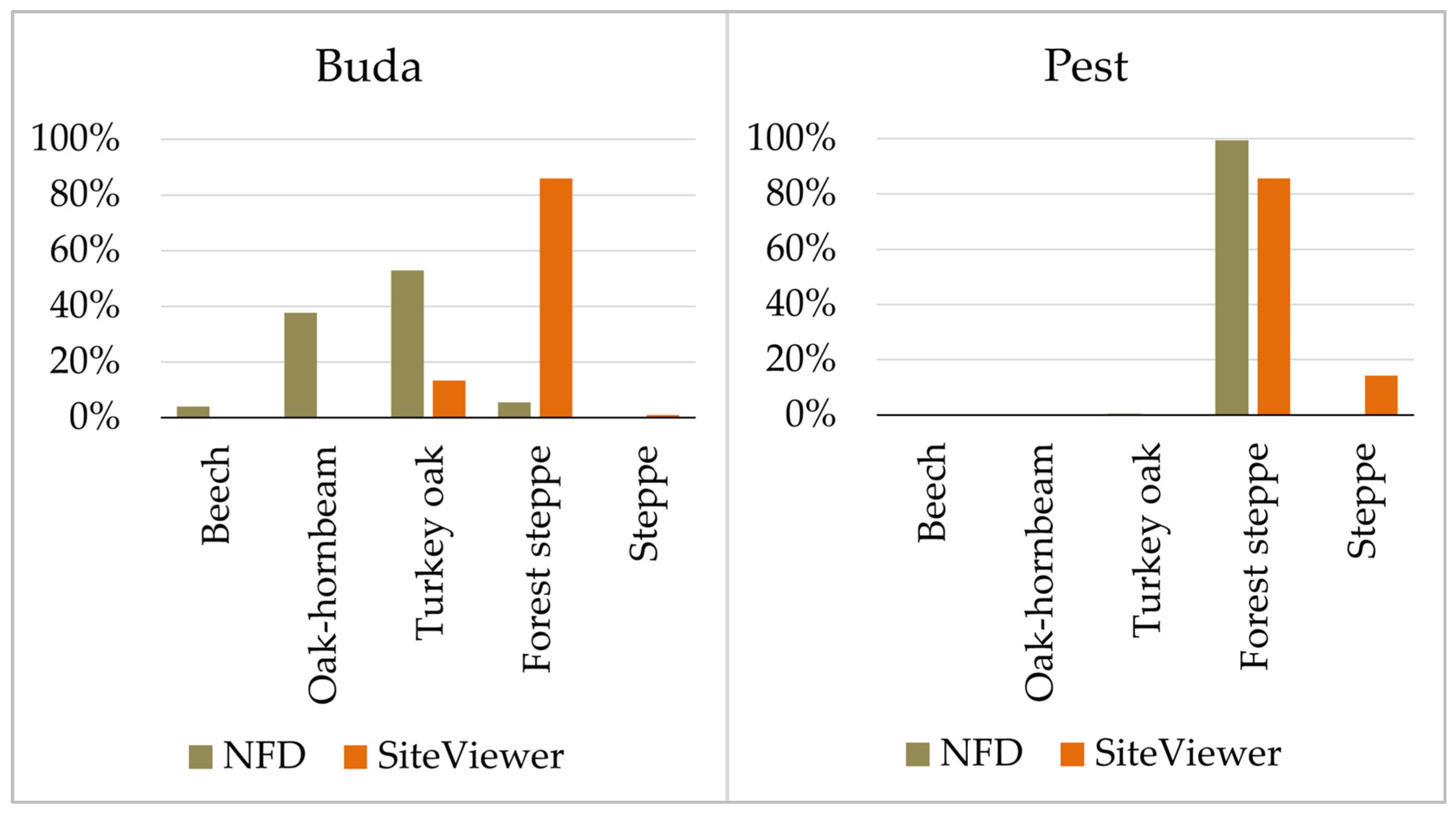
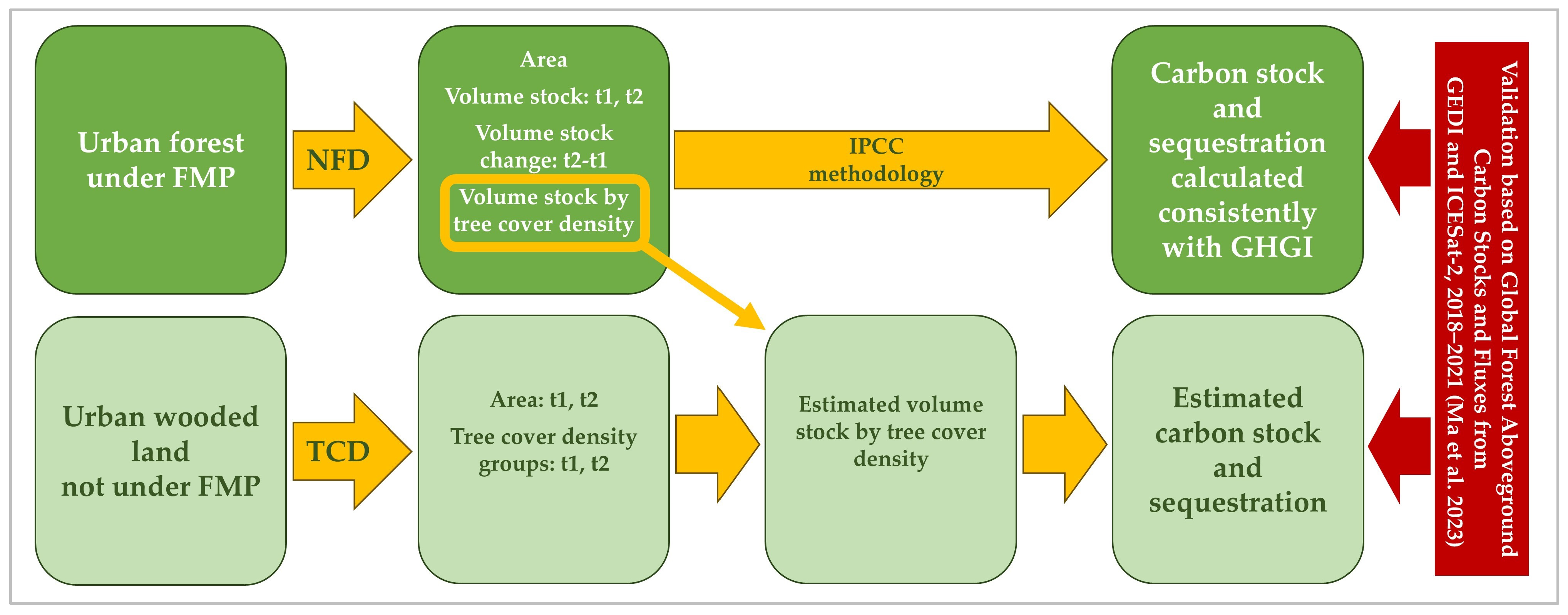
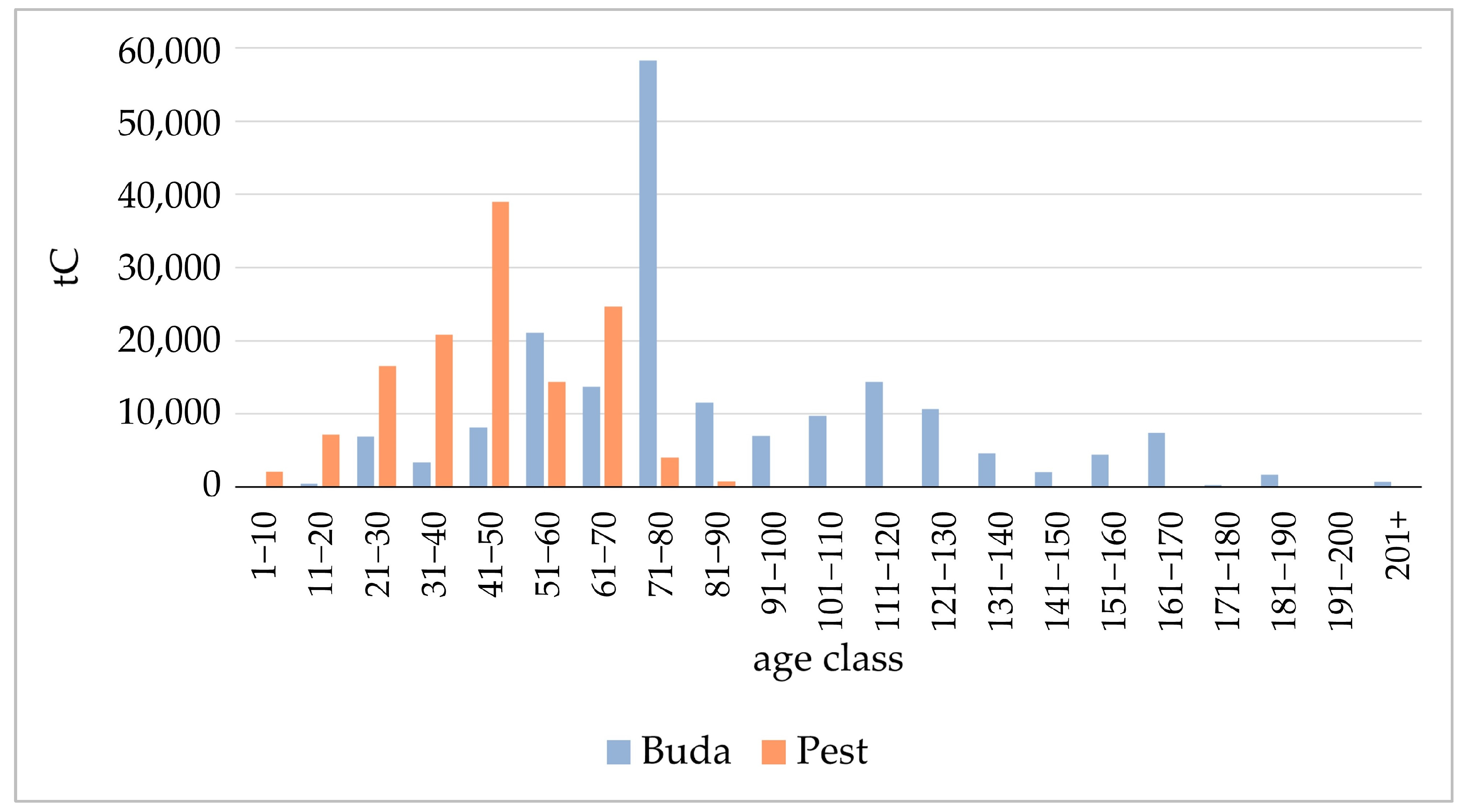
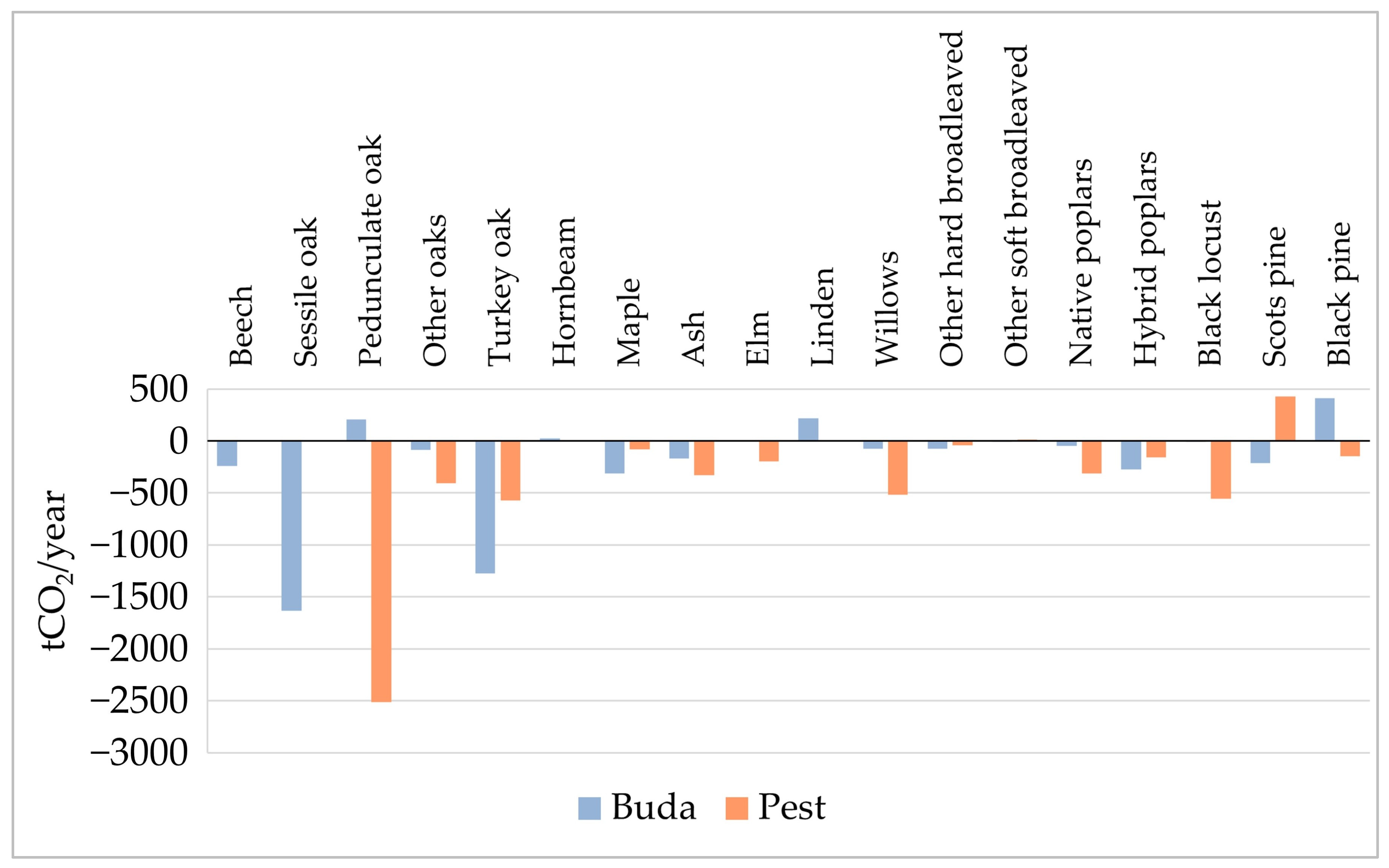


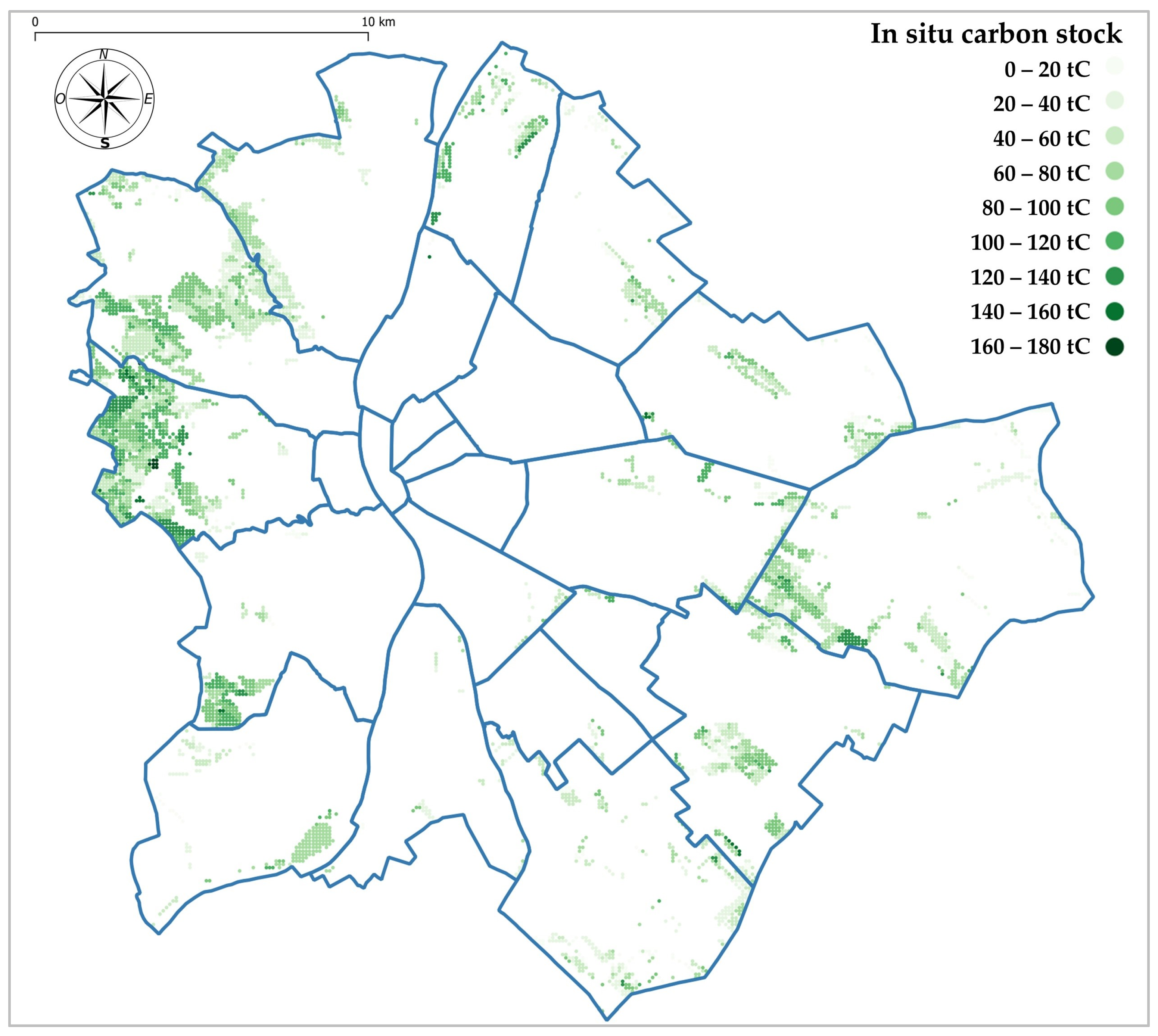
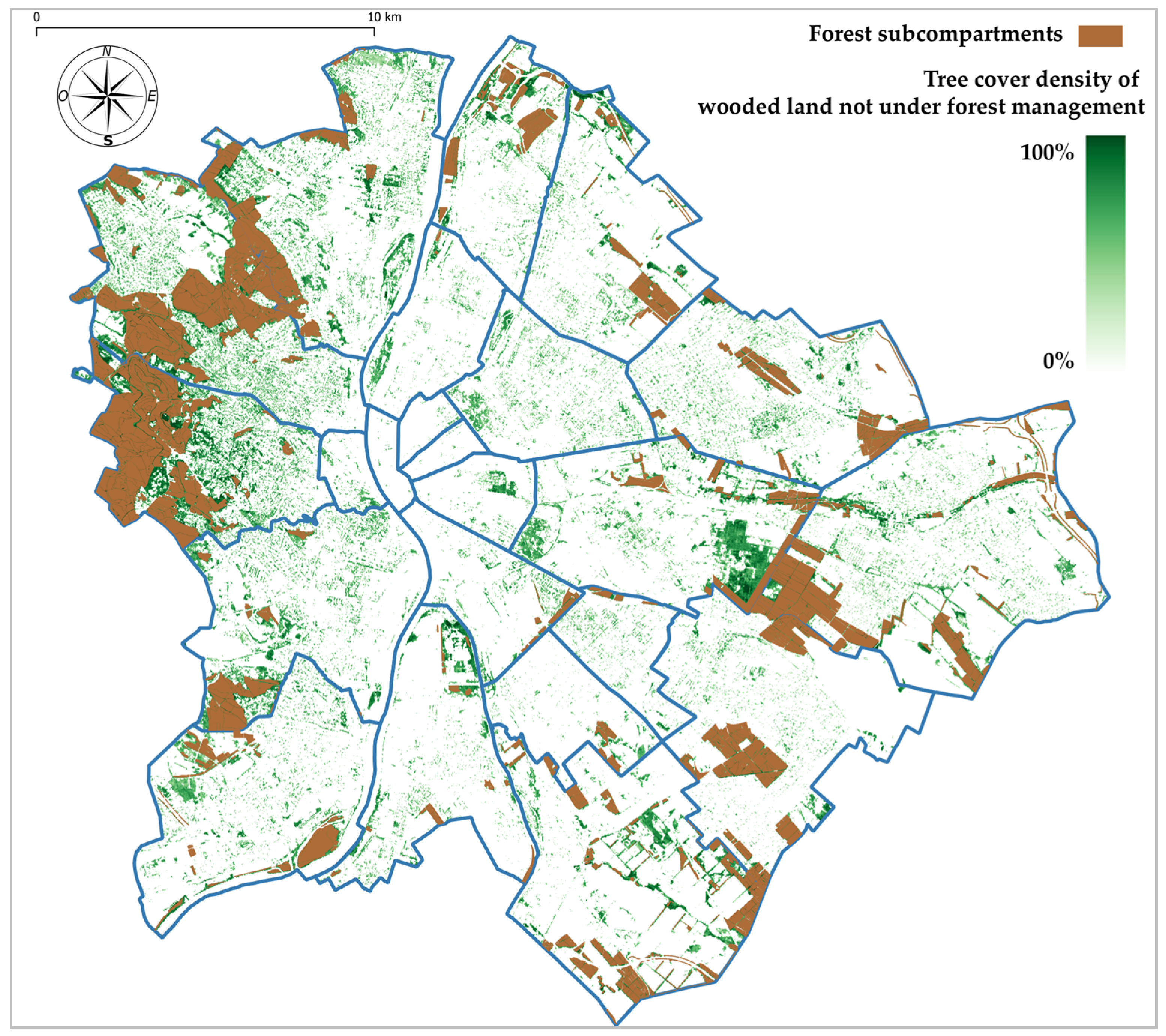
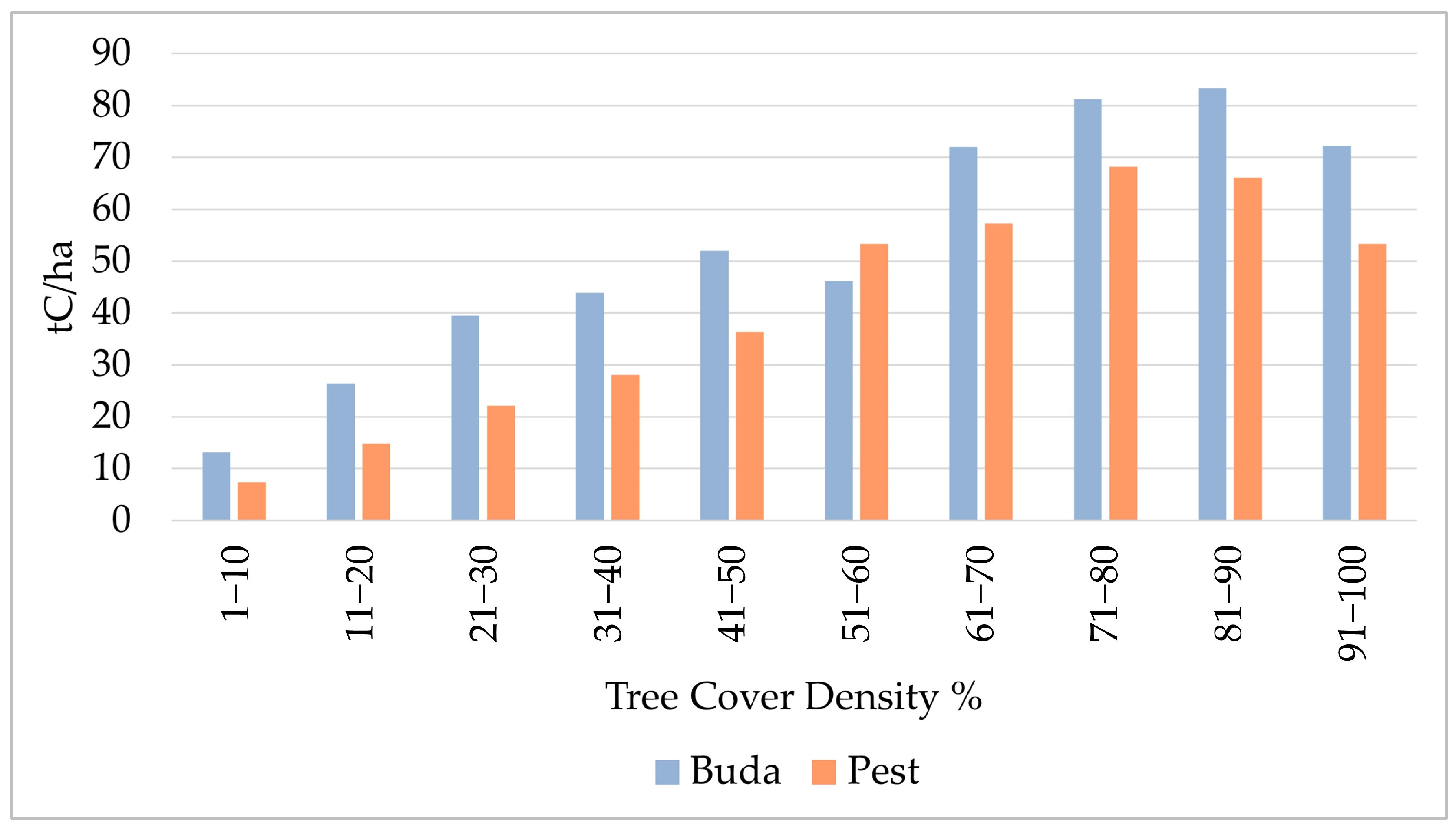


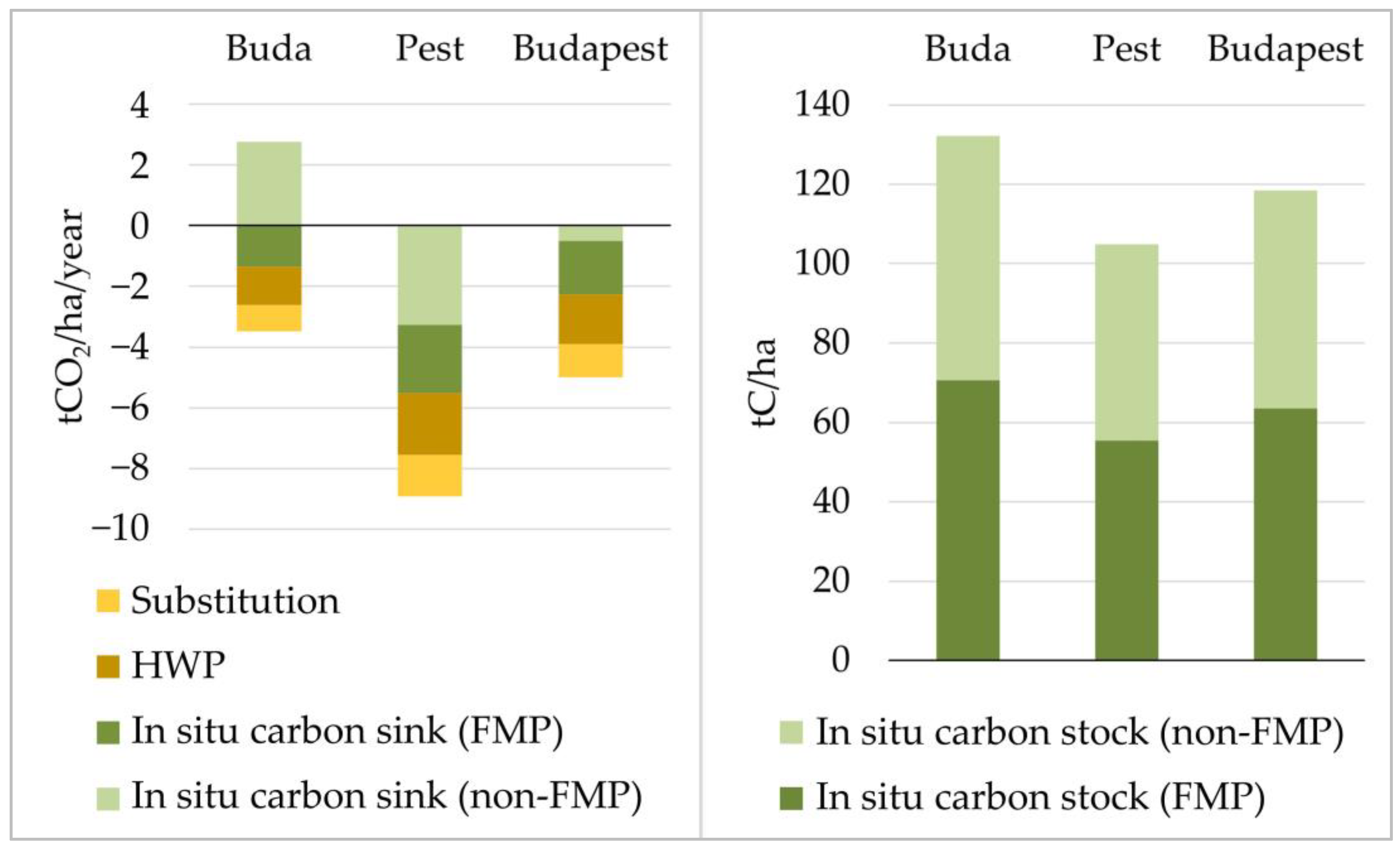

| Buda | Pest | Budapest | |
|---|---|---|---|
| In situ carbon sink of urban trees not under FMP (tCO2/ha/year) | 2.8 | −3.3 | −0.5 |
| In situ carbon sink of urban forests under FMP (tCO2/ha/year) | −1.3 | −2.2 | −1.8 |
| Average carbon stock of harvested timber (tCO2/ha/year) | −1.3 | −2.0 | −1.6 |
| Average energy substitution effect (tCO2/ha/year) | −0.9 | −1.4 | −1.1 |
| In situ carbon stock of urban trees not under FMP (tC/ha) | 61.6 | 49.4 | 55.0 |
| In situ carbon stock of urban forests under FMP (tC/ha) | 70.6 | 55.4 | 63.5 |
Disclaimer/Publisher’s Note: The statements, opinions and data contained in all publications are solely those of the individual author(s) and contributor(s) and not of MDPI and/or the editor(s). MDPI and/or the editor(s) disclaim responsibility for any injury to people or property resulting from any ideas, methods, instructions or products referred to in the content. |
© 2025 by the authors. Licensee MDPI, Basel, Switzerland. This article is an open access article distributed under the terms and conditions of the Creative Commons Attribution (CC BY) license (https://creativecommons.org/licenses/by/4.0/).
Share and Cite
Király, É.; Illés, G.; Borovics, A. Green Infrastructure for Climate Change Mitigation: Assessment of Carbon Sequestration and Storage in the Urban Forests of Budapest, Hungary. Urban Sci. 2025, 9, 137. https://doi.org/10.3390/urbansci9050137
Király É, Illés G, Borovics A. Green Infrastructure for Climate Change Mitigation: Assessment of Carbon Sequestration and Storage in the Urban Forests of Budapest, Hungary. Urban Science. 2025; 9(5):137. https://doi.org/10.3390/urbansci9050137
Chicago/Turabian StyleKirály, Éva, Gábor Illés, and Attila Borovics. 2025. "Green Infrastructure for Climate Change Mitigation: Assessment of Carbon Sequestration and Storage in the Urban Forests of Budapest, Hungary" Urban Science 9, no. 5: 137. https://doi.org/10.3390/urbansci9050137
APA StyleKirály, É., Illés, G., & Borovics, A. (2025). Green Infrastructure for Climate Change Mitigation: Assessment of Carbon Sequestration and Storage in the Urban Forests of Budapest, Hungary. Urban Science, 9(5), 137. https://doi.org/10.3390/urbansci9050137






